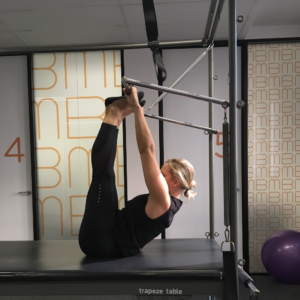The Trapeze Table, developed by Joseph Pilates in the 1940s, is a versatile piece of equipment that offers a wide range of exercises for all fitness levels. It was the first piece of apparatus designed by Joseph Pilates and is also the biggest and most imposing of all the Pilates equipment. It combines the benefits of traditional gym workouts with the added safety and convenience of a stationary platform, which is why we love using it in our classes and 1-1 Pilates sessions at Bend + Mend.
What is the Trapeze Table?
The trapeze table consists of a leather-clad table or “bed” area for lying on and four uprights positioned at each corner of the table, with an overhanging metal frame. The four uprights are covered in lots of small metal loops. These provide different attachment points for springs, pulleys, and resistance bands. Attached to the frame and floating above the table area are the trapeze bar and the stirrups. Between the two uprights of the table is a push bar. These features offer advanced exercises and increased resistance meaning that there is an endless number of exercises possible on the trapeze table.
Who is the Trapeze Table suitable for?
With its bed height and stable bed frame, this unique machine caters to beginners, elderly individuals, those recovering from injuries, as well as more advanced Pilates clients, making it ideal for a diverse range of clients. This comprehensive workout system challenges the body while providing feedback in various ways, ensuring that you achieve your fitness goals with precision and efficiency.
What are the benefits of using the Trapeze Table?
The Trapeze table, offers several benefits that make it a valuable piece of equipment for both rehabilitation and fitness enthusiasts.
Some key benefits include:
1. Versatility: The trapeze table can be used for a wide range of exercises targeting different body parts, including arms, legs, core and even the neck.
2. Support and safety: The apparatus is equipped with various attachments like springs, bars and straps which provide support and resistance. This makes it suitable for those recovering from injury as it supports the body weight and allowing for gentle, controlled movements.
3. Improved flexibility: The exercises performed on the table often involves stretching, which can significantly improve flexibility and range of motion.
4. Spinal decompression: Some exercises allow for gentle stretching of the spine, which can be beneficial for people with back issues, helping to alleviate pain and stiffness.
5. Core stability and balance: Many exercises enhance balance and core engagement, which help in strengthening the deep core muscles, improve posture and overall stability.
 Examples of Exercises on the Trapeze Table:
Examples of Exercises on the Trapeze Table:
– Pull downs and rotations
– Standing sideways balance
– Roll backs
– Lunges
– Donkey kick
– Teaser
– Chest press
– Cat stretch
Among many others!
We look forward to either introducing you to, or continuing your Pilates journey on our trapeze table in the clinic.





